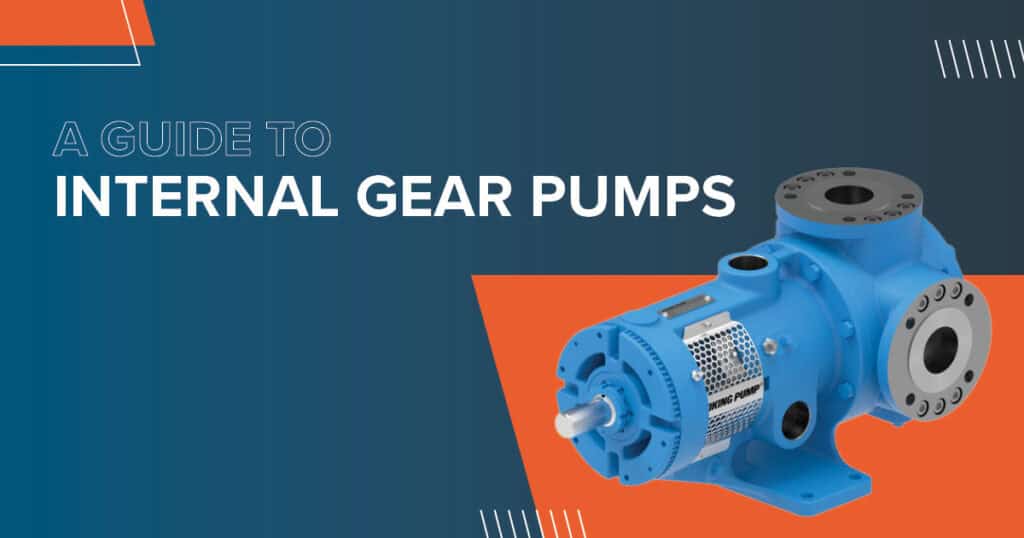Internal gear pumps are commonly used in a variety of industries because of their efficiency and versatility. This guide will help you gain a better understanding of internal gear pumps. We will talk about how they work and their common applications, as well as their advantages and disadvantages. Is an internal gear pump the right choice for your operation?
How Internal Gear Pumps Work
Internal gear pumps are a type of positive displacement pump that efficiently transfers fluids through a pump system using a pair of interlocking gears. The primary components of these pumps feature an internal gear, which is commonly known as the rotor. Then there is the external gear: the idler. It is positioned off-center within the rotor.
When the pump is activated, the rotor’s rotation creates a low-pressure zone at the pump’s inlet. This draws the process fluid into the housing. This fluid then occupies the spaces between the teeth of both the internal and external gears. As these gears continue to rotate, the fluid is carried from the inlet side to the outlet side of the pump. Upon reaching the discharge side, the interlocking gears mesh together. This motion forces the fluid out of the spaces and through the outlet. This meshing process not only expels the fluid but also maintains a continuous flow with minimal pulsation. The distinctive design of internal gear pumps allows them to handle a broad spectrum of fluid viscosities while ensuring a steady and smooth output. This is what makes them particularly suitable for applications requiring precision and reliability.
Common Applications and Industries
Internal gear pumps are used in a variety of applications as a result of their ability to handle both low- and high-viscosity fluids. In addition, they have the capabilities of maintaining steady flow and high-pressure output. Some common industries and applications include:
- Chemical Processing—They are often used to transfer aggressive chemicals and solvents because of their ability to handle corrosive fluids and maintain high-pressure delivery.
- Food and Beverage—Internal gear pumps are ideal for pumping food-grade liquids like oils, syrups, and juices because of their gentle handling, smooth flow, and reduced product degradation.
- Oil and Gas—These pumps are crucial to transfer fuels, lubricants, and other hydrocarbons. They can manage various viscosities and maintain steady flow rates, even with high-pressure requirements.
- Paints and Coatings—In the paint and coatings industry, internal gear pumps are used to move viscous materials like paints and resins.
- Pharmaceuticals—The ability to provide a clean, reliable flow makes them suitable for transferring delicate and high-purity fluids in pharmaceutical manufacturing.
Advantages of Internal Gear Pumps
Internal gear pumps offer several benefits that make them a preferred choice in many industries and applications:
- Versatility—They can handle a range of viscosities, from thin solvents to thick, viscous liquids.
- Smooth Flow—The pump design ensures a continuous, non-pulsating flow, which is crucial for applications requiring minimal fluid disruption.
- Self-Priming—Internal gear pumps are self-priming, which simplifies operations and maintenance.
- Compact Design—Their relatively small footprint makes them easy to integrate into various systems and allows for flexible installation options.
- Low Noise—The gear mechanism tends to operate quietly, making them suitable for environments where noise is a concern.
Disadvantages of Internal Gear Pumps
Despite their numerous advantages, internal gear pumps have some limitations:
- Cost—They can be more expensive than other types of pumps due to their complex design and construction.
- Sensitive to Contaminants—Internal gear pumps can be susceptible to damage from abrasive particles in the fluid. Over time this may lead to increased wear and maintenance requirements.
- Limited to Moderate Pressures—While they can handle a range of pressures, they are generally not suitable for extremely high-pressure applications.
Internal gear pumps are a crucial technology in various industries, offering a reliable and efficient solution for fluid transfer. Selecting the correct pump requires careful consideration of the application’s specific needs and the pump’s capabilities. To learn more about internal gear pumps and the best equipment from leading manufacturers like Viking, EnviroGear, and Liquiflo, contact DXP Pacific today. Let our team find the best pump for your specific application.

